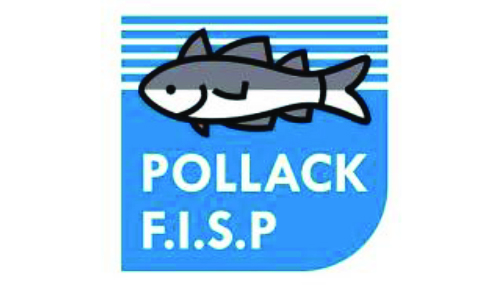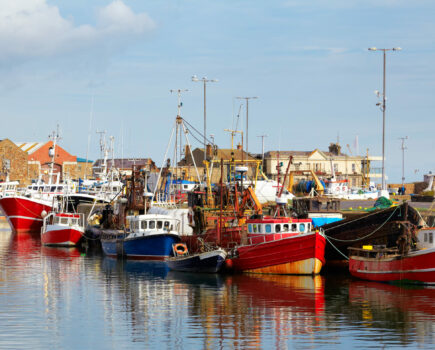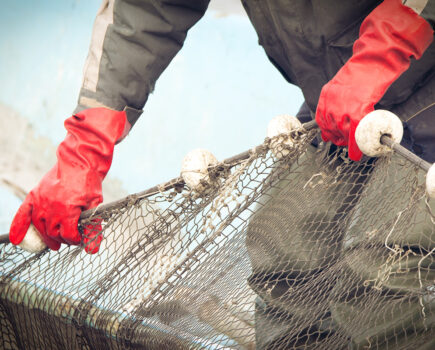Through the ongoing Pollack FISP, scientists from the universities of York and Plymouth are working with the industry to better understand the stock of this commercially important – but data-poor – species

By Dr Simon Thomas, University of York
Whether it is the sleek olive-green fresh run of fish of late spring, or the gnarled old warriors seen in the winter spawning season, pollack have been an integral part of my life for nearly 40 years, whether as a commercial fisherman, as an angler or now, as a fisheries scientist.
After 1969, the availability of the Mk 21 Decca Navigator allowed wrecks far out of sight
of land to be revisited, and the hitherto untapped hordes of pollack that congregated around these structures became a viable target for the commercial fleet and angling boats. Such was the impact of the system on fishing that some of us ‘old ’uns’ still think in Decca LOPs. As for many others, this (somewhat unreliable) system opened the doors for some truly exceptional landings of pollack, ling and cod.
MMO records show that 26,113t of pollack were landed into UK ports between 2008 and 2019, worth over £57m to the commercial fleet. The largest landings of pollack have been concentrated around ports in the South West of the UK, with Newlyn consistently recording the highest, although in recent years, Peterhead has surpassed Newlyn, mostly due to declines in landings at the latter port.
For many of the under-10m rod and line commercial fleet in the South West, these fish are a mainstay of fishermen’s catches, especially those without a bass entitlement.
The pollack Fisheries Industry Science Partnership (FISP) project was born from concerns among industry about perceived reductions in numbers and size of pollack in the South West.
Although official statistics suggested a decline in landings of pollack, it was clear that the scientific data for the species, especially in VIIe and VIId, was limited, with even the basic biology and ecology of pollack poorly understood. The lack of such data has implications for stock assessments for the species, and landings figures don’t account for the vagaries of market forces or movements and, crucially, lack an effort component.
The FISP fund, run by Defra, provided the perfect mechanism to finance this work. The project is split into two interlinked parts.
1. Acoustic tagging of pollack to obtain information on movements and site fidelity, led by Dr Emma Sheehan’s group at the University of Plymouth.
2. Interpol, led by Dr Bryce Stewart and myself at the University of York. We gather basic biological data crucial to future stock assessments such as age, growth, size at maturity, sex, stomach content and information on the spawning status and health of the fish. We also derive catch per unit effort (CPUE) from catch data from 13 charter boats across VIIe, and then model these data to ensure that the final index is representative of the whole of VIIe.

Live weights (tonnes) of pollack landed into four South West ports from 2002 to 2019.
Both projects rely heavily on the experience of the skippers belonging to the Professional Boatman’s Association, and the team at the Angling Trust, led by Hannah Rudd.
To age fish, we extract the otoliths or ear bones from the edge of the pollack brain and then prepare them in the laboratory. Otoliths form annual rings, much like those in a tree trunk. By counting these growth rings, we can accurately find the age of the fish. Age at size is an important parameter in many stock assessments, as these basic growth parameters are integral to the method used. These data are currently lacking for pollack in VIIe.
So how have we done? So far, the skippers have recorded and measured over 9,000 pollack from 492 trips. I have collected otoliths from 104 fish, sexed 462 fish (we have found an almost 2:1 ratio of male to female fish), and examined the stomach contents of many of these fish.

Liveweight landings of pollack from three major ports in the UK, 2008 to 2019.
By the end of the project, we will have sampled fish from two full spawning seasons, and have recorded CPUE for almost three years. In addition, we are collecting logbooks and records of trophy fish caught by anglers to produce a historical time-series of pollack sizes to expand our knowledge of what, if any, changes have occurred to the stock.
It is too early in the project to provide conclusions, but by the end, both elements of our research should provide a clearer picture of the state of the pollack stock in VIIe.

Simon Thomas extracting an otolith (ear bone) from the head of a pollack. These are used to age the fish.
Owen Malia, skipper of Outlaw, based in Dartmouth, who has over 40 years of experience fishing for pollack both commercially and as a charter skipper, said: “Since my involvement in the leisure sector, I have witnessed a fairly rapid decline in not only our catch rates, but also the seasonal sizes of pollack being caught/recorded by my anglers over the last eight to 10 years.” He added: “It has been no hardship to provide valued data for the project.”
To try to better understand any changes in pollack stocks, we will also look at the effects of environmental changes, such as water temperature and the increased presence of predators such as tuna.
Crucially, we will present these data to the fishing community at public meetings. This will ensure that those whose livelihoods are affected by management decisions have the chance to give their perceptions of our data, and for their views to feed into our final report.
Our model of fisheries science relies on close interactions between ourselves and those who spend their lives at sea – the experts by experience on the fish they target. This model can be extended to any data-limited species that has recreational value, or extended to incorporate commercial skippers. As true partners, the skippers are rewarded for their time and expertise.
The recent ICES advice for a zero TAC for pollack was based on landings and groundfish trawl surveys. Our data and project did not feed into that assessment at all. However, we very much hope that our research will improve the evidence base for future pollack stock assessments. As both a scientist and someone who has been involved in both the recreational and the commercial fishing industry, I know how important it is for management decisions to be based on the best available science when livelihoods are involved.
Dr Simon Thomas is a marine scientist who is theme leader for the data collection part of the pollack FISP. He is employed by the University of York, but is based in Plymouth. He has a PhD in marine ecology from Queens University (Belfast), and is also involved with ongoing projects on data collection on shark captures from the UK, using data supplied by charter skippers and anglers. He has been involved in fishing for most of his life. For more information on the pollack FISP project, especially if you would like to share your views on the fishery, please contact Simon at: simon.f.thomas@york.ac.uk

This story was taken from the latest issue of Fishing News. For more up-to-date and in-depth reports on the UK and Irish commercial fishing sector, subscribe to Fishing News here or buy the latest single issue for just £3.30 here.
Sign up to Fishing News’ FREE e-newsletter here.








